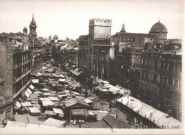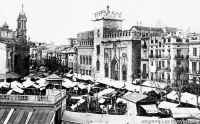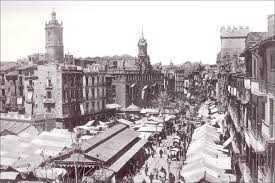-
Origins
The space currently occupied by the Central Market was, since the first expansion of the city, the habitual location of the itinerant markets. In 1839, it opens, in this location, an open market, the new market, the new market, the germ of the current Central Market. Towards the end of the nineteenth century, this market is clearly insufficient for the city of Valencia. For this reason, the city Council of Valencia summoned up to two constests for the construction of the new market.
-
Construction of the Market
In 1910, the city Council of Valencia convenes a new tender and of the six projects presented is chosen the one from architects Alejandro Soler March and Francisco Guardia Vial. Both educated in the School of Architecture in Barcelona and had worked in the team of collaborators of Luis Doménech Montaner, an architect who was characterized by a style within the lines of modernism.
The architects Alejandro Soler March and Francisco Guardia Vial, at the behest of the municipal corporation, modified the original project and the market was built according to the project dated in November 1914. The work was completed in 1928 by the architects Enrique Viedma and Angel Romani.
Alfonso XIII starred the protocol act with which the demolitions began. On October 24, 1910, with a silver pickaxe, he hit the wall of number 24 on the market square. Finally, on 23 January 1928, the current Central Market building in Valencia was inaugurated.
-
Its architecture
The spectacularity of the Central Market is undeniable. This is one of the most attractive and visited buildings int he city of Valencia. Its architecture doesn´t break the aesthetics of the square, where it integrates perfectly with two other important monuments: La Lonja de la Seda and Los Santos Juanes Church. It is, undoubtedly, the most representative building of Valencia that at the beginning of the twentieth century advances towards technological and mercantile progress and agricultural production is reflected in the modernist structure of the market and the allegorical ornamentation that we observe inside.
The cupolas, of iron, glass and ceramics (the Central one reaches 30 meters of height) and the vanes that crown them -the parrot and the fish- are integrated to a landscape panorama of towers and bellies eminently Valencian.
The distribution of the interior is rationalist, so the stalls are located along a series of rectilinear streets crossed by two broad pathways. It was conceived for 959 positions, destined in the general zone to high shops closed for butcher´s shop, corner shop and ironware; low stalls for potatoes, legumes, vegetables, fruits and hen; high-open shops for sale bread, poultry, meat and hunting meat; and, in the fish shop, high shops for sale of salt and offal , and low stalls for fish.
The two pavilions that flank the main access are built entirely in brick seen, with appñications of stone and decorated ceramics, while the annexed building of Deputy mayor follows the construction of influence Noucentista and remains topped by turrets crowned by small semi-spherical domes.
-
100 years of the first stone
It has already been held 100 years since the placement of the first stone and 90 from the first day that was opened to the public. "The Cathedral of the Senses". There is no better expression to convey what is the Central Market today. A sacred temple where the professors of the fresh products receive and transmit the wisdom of the most substantial, our nourishment. The magical light that enters from its dome and its windows, the permanent whisper that caresses the ears, the explosion of colors and aromas, the taste at he end of the classic and timeless flavors, mixed with the most surprising. A genuine theme park for gastronomy.
Like all municipal markets, it is also a fundamental element of the city and its neighborhoods. With its commercial activity, it makes possible in a natural way the cohesion and, the social exchange even at intercultural and intergenerational level, in a much more spontaneous and efficient way than any other initiative. In the markets not only you can buy and sell, you also taste, you talk about everything and you also live our history and our identity.
As a living organism it is, it has needed to reinvent itself continuously to reach this anniversary of its construction with excellent health. We must take advantage of new information and communication technologies (in which we were always pioneers) to offer online sales, delivery throughout Europe, free storage, etc, while completing the offer and services of the building, improving the space and expanding the shopping experience with culture, music, art literature and cuisine, a lot of cuisine.
On the occasion of the centenary, their Majesties the King of Spain, Felipe de Borbón and Mrs Letizia, who hold the honorary presidency of the centenary of the Central Market, visited on 24 November 2016 the Central Market. During their tour they greeted the sellers who day by day work to make this market the largest active market in Europe and signed in the Gold Book of the Central Market.
Although without doubt, the only thing that can guarantee that we continue 100 years, is the cohesion of its protagonists to think of a collective future that combines common interests.











